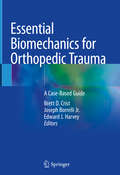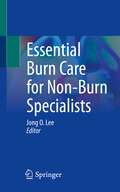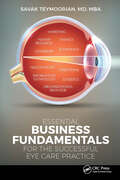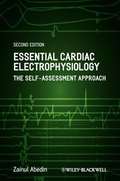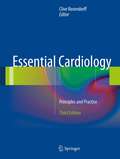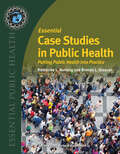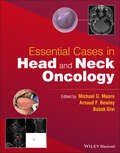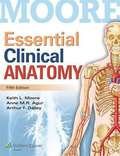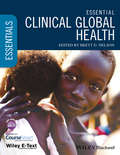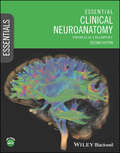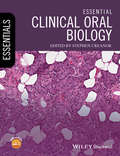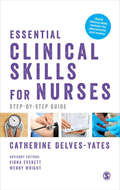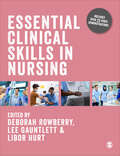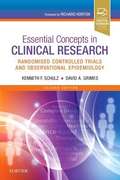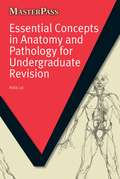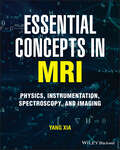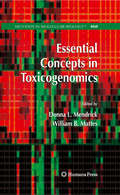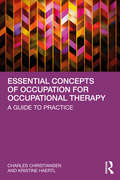- Table View
- List View
Essential Biomechanics for Orthopedic Trauma: A Case-Based Guide
by Joseph Borrelli Brett D. Crist Edward J. HarveyBiomechanics is often overlooked when dealing with orthopedic injuries, whether regarding prevention or treatment, and practicing surgeons and surgeons-in-training may feel overwhelmed when referring to a book with a more complicated basic science approach. In order to make the subject clinically relevant to orthopedic trauma surgery, this unique text presents numerous clinical case examples to demonstrate clearly and effectively the principles biomechanics of injury, fixation and fracture healing. Divided into five sections, the opening chapters cover the essentials of stress and strain relevant to bone and joints and how this relates to fractures and their healing, complete with illustrative case material. This case-based approach is carried throughout the book, with part two discussing biomechanical principles of external fixation for diaphyseal and periarticular fractures, limb lengthening and deformity correction. Tension band wiring for both olecranon and patella fractures are covered in part three, and both locking and nonlocking plates are illustrated in part four. The final section describes biomechanical principles of intramedullary nails for a variety of fractures and nonunions, as well as arthrodesis and lengthening. Generous radiological images and intraoperative photos provide a helpful visual enhancement for the clinical material. Making the sometimes esoteric topic of biomechanics more clinically relevant to the practicing clinician, Essential Biomechanics for Orthopedic Trauma will be an excellent resource not only for orthopedic surgeons, sports medicine specialists and trauma surgeons, but also medical and biomedical engineering students and residents.
Essential Burn Care for Non-Burn Specialists
by Jong O. LeeDespite a decreasing number of burns and improvement in mortality of burn patients in the United States, burn injuries are still frequent. Non-burn specialists such as emergency medicine physicians and primary care physicians will inevitably treat burn patients. In many instances, the first clinicians to see burn patients are non-burn specialists in the urgent care, emergency department, or primary care clinic, yet they typically do not have any formal training or exposure to burns in residency. As a result, many clinicians feel uneasy about managing burns even if the burn is minor. If a burn center is in a reasonable proximity, one can transfer the patient, but prior to transfer, or if no burn center is available, these clinicians may have to perform the initial management. It is important that they understand the basic principles of burn care. In times of burn disasters, non-burn specialists are needed to care for burn patients as burn centers can be quickly overwhelmed. They should be able to manage burn patients including stabilization, resuscitation and wound care. The text includes all current management available today for the care of burn patients. It is organized in a stepwise manner with clear information listed in sequential chapter formats. Chapter one offers the basic epidemiology of burn care while chapters three and four discuss the initial assessment and management. The chapter five discusses inhalation injury while the next three chapters focus on burn wound management including face and hand. The majority of chapters that follow center on a specific type of burn or burn patient. The last few chapters discuss aftercare including scar management and burn rehabilitation. Written by experts in the field, Essential Burn Care for Non-Burn Specialists is a valuable guide for any physician involved in burn treatment such as emergency physicians, primary care physicians, and general and plastic surgeons.
Essential Business Fundamentals for the Successful Eye Care Practice
by Savak TeymoorianA compact business education that strategically incorporates 500 keywords to lay the foundation and over 50 action items to initiate meaningful advances and excel in your eye care practice today. Medical training is a difficult journey with enormous amounts of information to absorb over a short time period. The intense time commitment required during this process leaves little opportunity to study any other discipline. However, even the most intelligent and well-intentioned provider cannot care for patients if the front door of the building is closed. Simply put: A fundamental background in business is required to effectively practice medicine. Eye care professionals, which includes their ophthalmic staff, can now fill the critical gap in their education with Essential Business Fundamentals for the Successful Eye Care Practice, providing them the necessary basic tools to make and execute winning practice management decisions. Writing in a high-density format that medical professionals will be familiar with, Dr. Savak Teymoorian combines his physician training and experience as a successful ophthalmologist at Harvard Eye Associates with the knowledge acquired earning his MBA. This unique perspective allows him to provide the proper theory and execution in the business of eye care and present it in an efficient manner like that used in medical education. Each chapter is dedicated to a different subject that would routinely be taught in a masters of business administration degree, tailored specifically for eye care professionals and distilled into the most critical information for a strong foundation. Each section is further enhanced with real life examples seen in ophthalmic care showing how to properly apply business strategies and tactics to obtain the best results.Chapter topics include: Marketing Leadership Negotiations Operations Finance Ophthalmologists, optometrists, and eye care staff will appreciate Essential Business Fundamentals for the Successful Eye Care Practice for its efficient and relevant information to running an eye care practice, whether they are currently in training and want to set themselves up for success or they are already practicing and want to fill in a deficiency in their knowledge.
Essential CNS Drug Development
by Stephen M. Stahl Amir Kalali Sheldon Preskorn Joseph KwentusCentral Nervous System disorders have an enormous impact on individuals and on society as a whole. The development of better treatments is crucial and is a major focus of pharmaceutical and biotechnology companies. This book explains the complicated process of CNS drug development in a way that is engaging for any interested professional or student. Chapters cover each stage of drug development, from pre-clinical research through all phases of clinical trials, to reporting to the regulatory authorities. Other key issues covered include strategic considerations, regulatory constraints, dissemination of results and ethical considerations. The user-friendly format and style enable readers to find important information quickly and easily. Written and edited by experts from different sectors actively engaged in CNS drug development, this is a unique resource for drug developers, investigators, academics and clinicians.
Essential Cardiac Electrophysiology
by Zainul AbedinThis concise collection of electrophysiological facts prepares you to face the clinical questions surrounding arrhythmia and conduction disorders with confidence. Clear and direct, the book offers: succinct factual information supported by illustrations, tables, and references self-assessment questions for each chapter, to test your knowledge of the area"Essential Cardiac Electrophysiology" summarizes the fundamental information that forms the basis of the modern approach to cardiac arrhythmias, from an explanation of the electrophysiologic effects of cardiac ion channel activity to the latest information on available implantable defibrillators. All members of the cardiac care team will benefit from keeping this valuable guide close at hand.
Essential Cardiology
by Clive RosendorffEssential Cardiology: Principles and Practices, 3rd Edition, blends molecular, cellular, and physiologic concepts with current clinical practice and provides up-to-date information on all major aspects of cardiovascular disease. Fully revised by an international panel of leading authorities in the field, it is an authoritative resource for cardiologists, internists, residents, and students. The book presents the clinical examination of the patient, including diagnostic testing and cutting-edge radiologic imaging; pathogenesis and treatment of various types of cardiac abnormalities; the needs of special populations, including pregnant, elderly, and renal-compromised patients; cardiovascular gene and cell therapy; and preventive cardiology. It includes new chapters on cardiovascular disease in women; diabetes and the cardiovascular system; and cancer therapy-induced cardiomyopathy. The Third Edition also focuses on the substantial advances in anti-platelet and anticoagulant therapy; new modalities of cardiac imaging; new anti-arrhythmic drugs; and a sophisticated understanding of vascular biology and atherogenesis.
Essential Case Studies in Public Health: Putting Public Health into Practice
by Katherine Hunting Brenda L. GleasonEssential Case Studies in Public Health: Putting Public Health into Practice is a unique compilation of twenty-one cases based on real life events and problems. Written by over forty public health faculty members and practitioners, these cases vividly illustrate how professionals across various disciplines tackle public health challenges. Covering a wide range of topics and issues from HPV vaccines as school entry requirements to implementing community-based water systems in rural Honduran communities to a mumps epidemic in Iowa, this text helps students apply a wide range of knowledge and skills relevant to public health outbreak investigation, policy analysis, regulatory decision-making and more. Important Notice: The digital edition of this book is missing some of the images or content found in the physical edition.
Essential Cases in Head and Neck Oncology
by Michael G. Moore Babak Givi Arnaud F. BewleyA case-focused Otolaryngology primer for trainees and practicing clinicians alike As disorders of the head and neck continue to become more prevalent, otolaryngologic head and neck surgeons are in greater demand than ever before. Many schools of medicine are integrating Problem-Based Learning (PBL) to help students develop the skills necessary for surgical management of head and neck conditions, yet the selection of guidebooks available to trainee otolaryngologic surgeons is limited. Essential Cases in Head and Neck Oncology uses real-life clinical cases to present clear and up-to-date explanations of treatment strategies for a wide range of cutaneous, salivary gland, and upper aerodigestive tract conditions, including benign and malignant tumors. Written and edited by renowned leaders in the field, and endorsed by the American Head & Neck Society, this essential resource contains full-color photographs, illustrations, and diagrams to better support readers in acquiring, synthesizing, and applying essential skills and knowledge in a clinical context. Its chapters provide detailed coverage of the oral cavity, skull base, trachea, thyroid, larynx, paragangliomas, salivary glands, and more. This textbook also includes: Covers the full spectrum of head and neck surgeries, including reconstructive procedures Discusses ethics related to cancer treatments, medical research, and other care issues Promotes multidisciplinary critical thinking, clinical problem-solving, communication, and collaboration Helps medical students and trainees evaluate their learning and contextualize their knowledge Features high-quality images and succinct explanatory text throughout Essential Cases in Head and Neck Oncology is an indispensable study aid for trainee clinicians, residents, and fellows studying for board certification and other exams, and an excellent reference guide for oncologists, otolaryngologists, surgeons, and other practitioners working in medical oncology, radiation oncology, and oromaxillofacial surgery.
Essential Clinical Anatomy
by Keith L. Moore Anne M. R. Agur Arthur F. Dalley"Get a practical perspective on gross anatomy that will help you understand the importance of anatomic structure and function. Based on the best-selling gross anatomy text, Clinically Oriented Anatomy, Keith Moore's Essential Clinical Anatomy features a succint, well-organized presentation of gross anatomy; boxed clinical information in every chapter; more than 400 full-color images illustrating arteries, nerves, veins, and muscles; 130 comprehensive tables; and surface anatomy highlighted in boxes throughout the text."--BOOK JACKET.Title Summary field provided by Blackwell North America, Inc. All Rights Reserved
Essential Clinical Anesthesia
by Charles A. Vacanti Pankaj Sikka Richard UrmanThe clinical practice of anesthesia has undergone many advances in the past few years, making this the perfect time for a new state-of-the-art anesthesia textbook for practitioners and trainees. The goal of this book is to provide a modern, clinically focused textbook giving rapid access to comprehensive, succinct knowledge from experts in the field. All clinical topics of relevance to anesthesiology are organized into 29 sections consisting of more than 180 chapters. The print version contains 166 chapters that cover all of the essential clinical topics, while an additional 17 chapters on subjects of interest to the more advanced practitioner can be freely accessed at www. cambridge. org/vacanti. Newer techniques such as ultrasound nerve blocks, robotic surgery, and transesophageal echocardiography are included, and numerous illustrations and tables assist the reader in rapidly assimilating key information. This authoritative text is edited by distinguished Harvard Medical School faculty, with contributors from many of the leading academic anesthesiology departments in the United States and an introduction from Dr S. R. Mallampati. This book is your essential companion when preparing for board review and recertification exams and in your daily clinical practice.
Essential Clinical Anesthesia Review: Keywords, Questions and Answers for the Boards
by Richard D. Urman Linda S. Aglio Robert W. Lekowski Linda S. Aglio Robert W. LekowskiThis concise, evidence-based board review book, organized according to the ABA keyword list, covers all the fundamental concepts needed to pass written and re-certification board examinations. Each chapter begins with a case scenario or clinical problem from everyday practice, followed by concise discussion and clinical review questions and answers. Discussion progresses logically from preoperative assessment and intraoperative management to postoperative pain management, enhancing the reader's knowledge and honing diagnostic and clinical management skills. New guidelines and recently developed standards of care are also covered. Serving as a companion to the popular textbook Essential Clinical Anesthesia, this resourceful work reflects the clinical experiences of anesthesia experts at Harvard Medical School as well as individually known national experts in the field of anesthesiology. This practical review is an invaluable resource for anesthesiologists in training and practice, whether studying for board exams or as part of continuing education and ABA recertification.
Essential Clinical Global Health
by Brett D. NelsonEssential Clinical Global Health is a brand-new, pioneering, and evidence-based textbook that provides a clinical overview of the increasingly prominent specialty of global health. Originally developed from a course at Harvard Medical School, and now with contributions from nearly 100 world-renowned global health experts from across the globe, this textbook presents vital information required of students, trainees, and clinicians during their international experiences and training.Essential Clinical Global Health introduces readers to the up-to-date knowledge, skills, and approaches needed for productive and rewarding global health experiences. It provides essential clinical information on the diagnosis, management, and prevention of the leading causes of morbidity and mortality in low- and middle-income countries. The textbook also includes practical guidance on topics such as health systems, population-based approaches, cultural awareness and sensitivity, travel preparedness and safety, and career development in global health.With key learning objectives in each chapter, practical clinical advice, setting-appropriate guidelines, personal field experiences from student and clinician contributors, Essential Clinical Global Health is the first global health textbook with a clinical focus for healthcare students, trainees, and providers.
Essential Clinical Global Health (Essentials)
by Brett D. NelsonEssential Clinical Global Health is a brand-new, pioneering, and evidence-based textbook that provides a clinical overview of the increasingly prominent specialty of global health. Originally developed from a course at Harvard Medical School, and now with contributions from nearly 100 world-renowned global health experts from across the globe, this textbook presents vital information required of students, trainees, and clinicians during their international experiences and training. Essential Clinical Global Health introduces readers to the up-to-date knowledge, skills, and approaches needed for productive and rewarding global health experiences. It provides essential clinical information on the diagnosis, management, and prevention of the leading causes of morbidity and mortality in low- and middle-income countries. The textbook also includes practical guidance on topics such as health systems, population-based approaches, cultural awareness and sensitivity, travel preparedness and safety, and career development in global health. With key learning objectives in each chapter, practical clinical advice, setting-appropriate guidelines, personal field experiences from student and clinician contributors, Essential Clinical Global Health is the first global health textbook with a clinical focus for healthcare students, trainees, and providers.A companion website at www.wileyessential.com/globalhealth features self-assessment questions and videos.
Essential Clinical Neuroanatomy (Essentials)
by Thomas ChampneyEssential Clinical Neuroanatomy is an accessible introduction to regional and functional neuroanatomy, which cuts through the jargon to help you engage with the key concepts. Beautifully presented in full color, with hundreds of annotated illustrations and images, Essential Clinical Neuroanatomy begins with an introductory section on the regional aspects of the topic, then discusses each structure in detail in relation to function. Clinical examples are provided throughout, to reinforce the concepts learned and highlight their clinical relevance. Essential Clinical Neuroanatomy: Features a dedicated chapter on the use of imaging studies used in clinical neuroanatomy, including how to evaluate these images Highlights topics important to clinical medicine, but often neglected in other neuroanatomy texts, such as trauma, infection and congenital considerations All illustrations and images are oriented in the clinical view, so the correlation between drawings, photomicrographs and clinical imaging is standardized and there is a seamless transition between illustrations containing basic neuroanatomical information and the relevant clinical imaging The functional aspects of neuroanatomical structures are color-coded (green = sensory; red = mot∨ purple = autonomic), so that structure to function relationships can be more easily learned and retained Includes self-assessment and thought questions in every chapter Supported by a companion website at wileyessential. com/neuroanatomy featuring fully downloadable images, a series of PowerPoint lectures for instructors, and USMLE-compatible MCQs Essential Clinical Neuroanatomy is the perfect resource for medical and health science students taking a course on neuroanatomy, as part of USMLE teaching and as an on-going companion during those first steps in clinical practice.
Essential Clinical Neuroanatomy (Essentials)
by Thomas H. ChampneyESSENTIAL CLINICAL NEUROANATOMY The Essentials is an international, best-selling series of textbooks, all of which are designed to support lecture series or themes on core topics within the health sciences. See www.wiley.com for further details. Accessible, visually stimulating guide to clinical neuroanatomy, striking the perfect balance between regional and functional content Essential Clinical Neuroanatomy, 2nd Edition discusses the anatomy of the nervous system from the clinical perspective in easy-to-understand language, providing descriptions of the sensory, motor, and integration systems within the nervous system. Illustrations are included throughout in the clinical view using the gold standard computed tomography and magnetic resonance imaging modalities. To enable seamless reader comprehension, the text includes case studies, study questions, boxes of interest to highlight the clinically relevant neuroanatomy, learning objectives, an outline of each chapter’s material to be covered, multiple choice questions, and further reading resources. Essential Clinical Neuroanatomy, 2nd Edition contains information on: Topics important to clinical medicine, but often neglected in other neuroanatomy texts, such as trauma, infection, and congenital considerations Includes recent reviews and references with a focus on the cortical chapter and the imaging chapter where there is significant ongoing research Revised figures and illustrations to reflect more cultural diversity Two new chapters on the peripheral and autonomic nervous systems Use of imaging studies used in clinical neuroanatomy, including how to evaluate these images Neuroanatomy of the central nervous system, covering an overview of the nervous system, blood vessels, meninges, and ventricles, neurodevelopment, the spinal cord, brain stem, cerebellum and cortex Sensory, motor, and integration systems, covering the visual system, auditory and vestibular system, olfaction and taste, central motor control, the limbic system and cortical integration Essential Clinical Neuroanatomy, 2nd Edition is the perfect resource for medical and health science students taking a course on neuroanatomy and as an on-going companion during those first steps in clinical practice. The text is also useful for those reviewing neuroanatomy for major licensing or competency examinations (National Board of Medical Examiners (NBME) United States Medical Licensure Exams (USMLE).
Essential Clinical Oral Biology
by Stephen CreanorEssential Clinical Oral Biology is an accessible guide to oral biology, introducing the scientific knowledge necessary to succeed in clinical practice. Student-friendly layout with clinical photographs throughout Each chapter has clearly defined key topics and learning objectives Covers the essentials: what you need to know and why Companion website featuring interactive MCQs, teaching presentations and downloadable images
Essential Clinical Skills for Nurses: Step by Step
by Catherine Delves-YatesThis little book is an ideal clinical skills reference for nursing students and junior health care practitioners. Its easy to navigate design and step-by-step approach allows for information to be accessed quickly to help students review skills while on placement and prepare for their OSCE exams. - Essential equipment tick lists helps ensure students know what they need to perform clinical skills. - Patient considerations promote strategies to provide the best possible care. - All fields of nursing are covered with tips throughout to help students support every patient group. - Introduces different approaches to performing clinical skills in community and acute settings to help students and new practitioners feel confident performing the skill in any situation.
Essential Clinical Skills for Nurses: Step by Step
by Catherine Delves-YatesThis little book is an ideal clinical skills reference for nursing students and junior health care practitioners. Its easy to navigate design and step-by-step approach allows for information to be accessed quickly to help students review skills while on placement and prepare for their OSCE exams. - Essential equipment tick lists helps ensure students know what they need to perform clinical skills. - Patient considerations promote strategies to provide the best possible care. - All fields of nursing are covered with tips throughout to help students support every patient group. - Introduces different approaches to performing clinical skills in community and acute settings to help students and new practitioners feel confident performing the skill in any situation.
Essential Clinical Skills in Nursing
by Deborah Rowberry Lee Gauntlett Libor HurtYour complete solution for modern clinical skills education Accompanied by over 25 videos and written by an experienced team of nursing educators and practitioners, this innovative textbook will support your clinical skills training across all years of your degree. Taking a holistic and inclusive approach, the book presents both the theory, rationale and ‘how to’ of each procedure, as well as crucial interconnected skills such as communication, clinical reasoning and person-centred practice. Written in clear, straightforward language and mapped to the NMC Future Nurse Standards, the book delivers a complete solution for mastering the essential clinical skills you need as a student and registered nurse. How will the book support my learning? · Offers access to more than 25 videos alongside the text, demonstrating clinical skills in practice, from oxygen administration to venepuncture, cannulation and more · Structured around the 2018 NMC standards procedures annexe providing full curriculum coverage · Draws on over 30 case study scenarios and ‘voices’ from real pre-registration nursing students that bring clinical skills to life · Includes over 60 activities, key term definitions and other features to hone your understanding through self-testing, reflection and critical thinking · Relevant to students across all four fields of nursing
Essential Clinical Skills in Nursing
by Deborah Rowberry Lee Gauntlett Libor HurtYour complete solution for modern clinical skills education Accompanied by over 25 videos and written by an experienced team of nursing educators and practitioners, this innovative textbook will support your clinical skills training across all years of your degree. Taking a holistic and inclusive approach, the book presents both the theory, rationale and ‘how to’ of each procedure, as well as crucial interconnected skills such as communication, clinical reasoning and person-centred practice. Written in clear, straightforward language and mapped to the NMC Future Nurse Standards, the book delivers a complete solution for mastering the essential clinical skills you need as a student and registered nurse. How will the book support my learning? · Offers access to more than 25 videos alongside the text, demonstrating clinical skills in practice, from oxygen administration to venepuncture, cannulation and more · Structured around the 2018 NMC standards procedures annexe providing full curriculum coverage · Draws on over 30 case study scenarios and ‘voices’ from real pre-registration nursing students that bring clinical skills to life · Includes over 60 activities, key term definitions and other features to hone your understanding through self-testing, reflection and critical thinking · Relevant to students across all four fields of nursing
Essential Concepts In Clinical Research: Randomised Controlled Trials And Observational Epidemiology
by David A. Grimes Kenneth SchulzThis practical guide speaks to two audiences: those who read and those who conduct research. Clinicians are medical detectives by training. For each patient, they assemble clinical clues to establish causes of signs and symptoms. The task involves both clinical acumen and knowledge of medical research. This book helps guide clinicians through this detective work, by enabling them to make sense of research and to review medical literature critically. It will also be invaluable to researchers who conduct clinical research, particularly randomized controlled trials. <p><p> Building on previously published, peer-reviewed articles from The Lancet, this handbook is essential for busy clinicians and active researchers interested in research methods. <p> Written by leaders in the field of clinical research who have published extensively with authorship of hundreds of articles in medical journals. The authorship includes one of the three authors of the CONSORT guidelines for the reporting of randomized controlled trials. <p> The book presents the essential concepts to a wide array of topics including randomized control trials, descriptive studies, cohort studies, case-control studies, bias, and screening tests. <p> The book utilises a readable and humorous prose style, lightening what can be a difficult area for clinical readers. <p> Derived from decades of teaching clinical research in seminar settings the book will empower clinicians to make sense of, and critically appraise, current medical research and will enable researchers to enrich the quality of their work. For this Second Edition, the authors have revised and updated the original 16 chapters and added six new chapters. For busy clinicians and active researchers interested in research methods, this book provides helpful tools to derive satisfaction - indeed, fun - from clinical science.
Essential Concepts in Anatomy and Pathology for Undergraduate Revision (MasterPass)
by Aida LaiAnatomy and pathology are key areas in medical training, but the amount medical students have to learn within them can seem overwhelming. This book helps students gain a firm grasp of the facts they must know before they enter their clinical years. It encompasses the core basics of the major organ systems in the body and presents them in a memorable, easy-to-read form. The book covers the background and knowledge that are clinically relevant to, and commonly encountered in, end-of-semester exams and provides a solid preparation for clinical years. It is an excellent resource for all medical students wishing to gain and retain anatomy and pathology knowledge in a time-effective manner.
Essential Concepts in MRI: Physics, Instrumentation, Spectroscopy and Imaging
by Yang XiaESSENTIAL CONCEPTS IN MRI A concise and complete introductory treatment of NMR and MRI Essential Concepts in MRI delivers the first comprehensive look at magnetic resonance imaging with a practical focus on nuclear magnetic resonance spectroscopy applications. The book includes the essential components of MRI and NMR and is written for anyone new to the field of MRI who seeks to gain a complete understanding of all four essential components of MRI: physics theory, instrumentation, spectroscopy, and imaging. Highly visual and including numerous full color figures that provide crucial graphical descriptions of key concepts discussed in the book, Essential Concepts in MRI includes discussions of quantitative and creative MRI, as well as spatial mapping in MRI and the effects of the field gradient and k-space imaging. The book also covers: A thorough introduction to essential concepts in nuclear magnetic resonance, including classical descriptions of NMR and quantum mechanical descriptions of NMR Comprehensive explorations of essential concepts in NMR instrumentation, including magnets, radio-frequency coils, transmitters, and receivers Practical discussions of essential concepts in NMR spectroscopy, including simple 1D spectroscopy, double resonance, and dipolar interactions in two-spin systems In-depth examinations of essential concepts in MRI, including the design of MRI pulse sequences and the elements of MRI instrumentation, with a special focus on quantitative MRI Essential Concepts in MRI is a must-read reference for upper-level undergraduate and postgraduate students in the physical and medical sciences, especially radiology, MRI, and imaging courses. It is also essential for students and researchers in the biomedical sciences and engineering.
Essential Concepts in Toxicogenomics
by Donna L. Mendrick William B. MattesThe field of toxicogenomics has been growing quickly, yet with rapid growth comes the need to periodically reflect on the nature of the field. Essential Concepts in Toxicogenomics collects reviews, opinion pieces and case studies from the leading experts in this dynamic field with a focus on its application to pharmaceuticals. Topics covered include issues that affect the quality of toxicogenomics experiments, statistical approaches to their data analysis, the use of such data to build toxicogenomic models, and the utilization of genomics to identify biomarkers within the preclinical and clinical arenas. Although not in the standard Methods in Molecular BiologyTM series format, this volume retains the practicality and usefulness of the highly successful series. Informative and cutting-edge, Essential Concepts in Toxicogenomics is an ideal resource for pharmaceutical companies, chemical manufacturers, toxicologists, and all who must keep up-to-date on progress in this vital and important field.
Essential Concepts of Occupation for Occupational Therapy: A Guide to Practice
by Charles Christiansen Kristine HaertlEssential Concepts of Occupation for Occupational Therapy is an accessible introduction to vital concepts in occupational science for the occupational therapy practitioner or student. It invites therapists to view and understand their clients differently—by using an “occupational lens” to focus on the lives of their clients as everyday doers. It addresses the key questions at the heart of understanding humans as occupational beings: What do people typically do? And, where, when, how, why, and with whom do they do it? These questions organize the key concepts from occupational science that form the first chapters of this book, enabling therapists to better understand their clients—and enabling their clients to better understand the importance of occupation to their well-being. Additional chapters clearly describe how therapists can use occupation-based models to apply an expanded view of occupation and make evaluation and intervention more relevant and beneficial to their clients. A final chapter examines trends and lifestyle changes occurring in the 21st century to anticipate how these might impact future practice. Through use of engaging and thoughtful cases that illustrate many of the concepts, this guide will help practitioners clearly understand their clients as doers, while also providing enhanced ways for therapist to confidently apply these concepts in practice.
